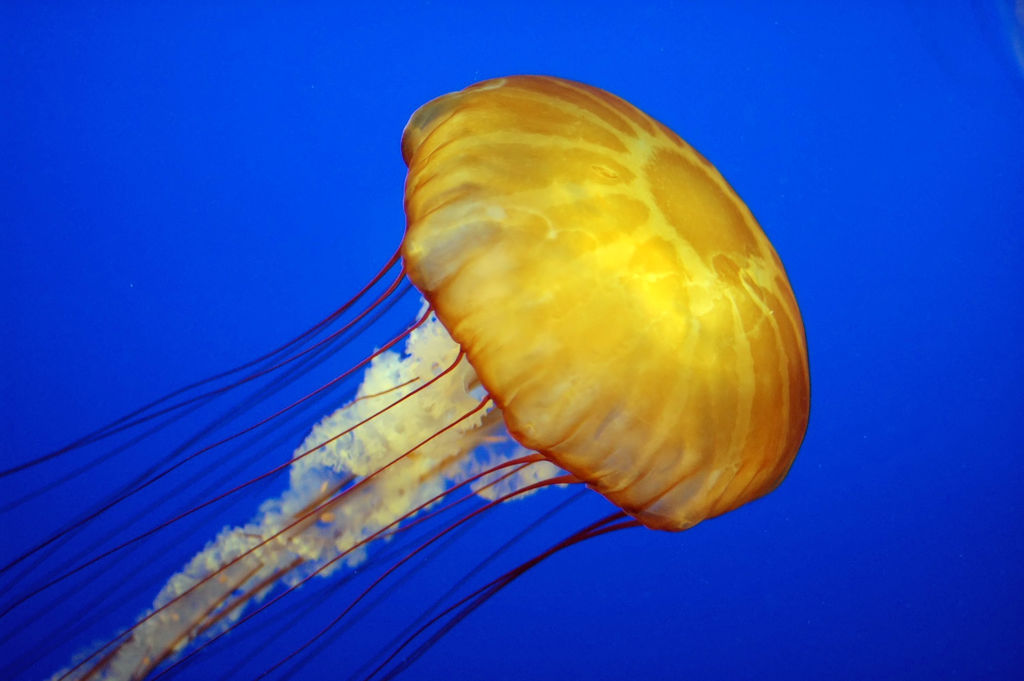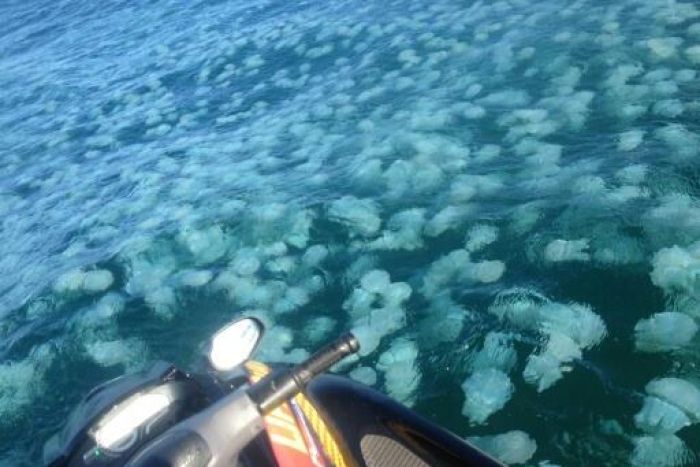Ocean acidification and the rise of jellyfish
 Of all the falling dominos caused by increased carbon dioxide in the atmosphere, ocean acidification is the most recent to be observed. Only since 2005 have scientists realised that a third of all carbon dioxide emissions dissolve into the ocean.
Of all the falling dominos caused by increased carbon dioxide in the atmosphere, ocean acidification is the most recent to be observed. Only since 2005 have scientists realised that a third of all carbon dioxide emissions dissolve into the ocean.
When CO2 is dissolved into seawater the pH level drops and its acidity increases. This threatens marine organisms that build their protective shells and skeletons out of calcium carbonate, such as oysters and corals. When the seawater becomes too acidic their protective structures begin to dissolve.
To date, the only research on ocean acidification has concerned organisms that will suffer from increased acidity, however a recently released paper presented evidence of a class of organism that will thrive in warmer and more acidic oceans.
And the winners of this hothouse lottery? Jellyfish.
The two scientists who wrote the paper, Professor Jason Hall-Spencer and Rohan Allen began their research after scuba diving at underwater 'hot spots'.
“What started us thinking that this might be a big issue,” said Hall-Spencer, “is that I've been diving on underwater volcanoes all over the world where carbon dioxide bubbles out like a jacuzzi.”
Volcanic activity at hot spots causes CO2 to bubble up from the sea floor acidifying large areas of ocean, this creates ideal conditions to study the future effects of ocean acidification.
“Whenever I go to these places there's often lots and lots of jellyfish in the water and invasive types of seaweeds,” says Prof Hall-Spencer. “And what I think we may be doing [by acidifying the ocean] is opening the door to this problem worldwide.”
Based on their evidence the scientists predict “Blooms of stinging jellyfish to increase since they are highly resilient to acidification.”
“We suspect that there will be an increase in nuisance species, as many have traits that are resilient to the combined warming and acidification caused by rising CO2 levels”
By 'jellyfish', Hall-Spencer and Allen refer to a class of organism. Gelatinous zooplankton to be exact and they're considered a 'nuisance species' because they have undesirable effects on humans. Yeah, they sting.
Though they're the first to study the link between ocean acidification and jellyfish, past studies have shown an overall increase in jellyfish populations. A 2012 paper found that global jellyfish populations were increasing due to human factors, though in that case ocean acidification wasn't mentioned.
Also, a recent study showed the potentially-fatal Irukandji jellyfish might begin migrating south from northern Queensland if ocean temperatures rise as expected. However, not all jellyfish are as dangerous as the Irukandji or it's close relative the box jellyfish, and not all jellyfish live in tropical waters.
 In March this year a bloom of 'blue blubber' jellyfish occurred off Coolum Beach on the Sunshine Coast (see image at left), while last December a similar bloom of blue blubbers happened in Moreton Bay at Redcliffe. In January this year a bloom washed ashore at Shelly Beach, Ballina
In March this year a bloom of 'blue blubber' jellyfish occurred off Coolum Beach on the Sunshine Coast (see image at left), while last December a similar bloom of blue blubbers happened in Moreton Bay at Redcliffe. In January this year a bloom washed ashore at Shelly Beach, Ballina
Last March a never-before-seen purple jellyfish washed up at Coolum Beach while another very similar jellyfish washed up at Ballina.
Many types of jellyfish live in cooler water too, yet so far they've shown to be less of a nuisance. The Lion's mane jellyfish – which is the largest known jellyfish - inhabits Australia's southern coastline. Whenever the media reports on a 'monster jellyfish washing ashore' it's inevitably a Lion's mane jellyfish. The only serious injury occurred in 2002 when a swimmer was stung on the eye in southern NSW. When Lion's Mane jellyfish break apart they can sting many people.
The study by Professor Spencer-Hall and Rohan Allen ended with a familiar refrain about reducing CO2 emissions. “What we don't want,” says Professor Hall-Spencer, “is stinging jellyfish on the beaches wherever we go."


Comments
"Gelatinous zooplankton to be exact and they're considered a 'nuisance species' because they have undesirable effects on humans"
They are delicious in a fresh mint salad.
I like your attitude mk1: When life gives you lemons, make a zesty jellyfish salad.
Often served in Japanese Isakaya's as an accompaniment to beer too. I love the stuff.
Wondering if there's a way they could be harvested and used in fertiliser or fish meal or something along those lines?
Went to dinner with the missus, son and his girlfriend, only about a month ago at the local Sushi-train. The fam wouldn't touch the jellyfish dish and challenged old garbage guts (yours truly) to try it. Must say, was pleasantly surprised. Not bad at all.
Garbage Guts, I think we're kinda missing the point of the article though.
Not at all, Zen. Just send Garbage Guts out there with a tub of wasabi and a bottle of soy sauce. Problem solved!
We can eat our way out of this
Haha classic.
These Blue blubbers are a pain in the ......!
Arms, feet, Legs, feet, Face and or Leggie.
Had a session out TOS last feb, solid 4-5 grunty peaks, 3-5 people out, strange I thought.
Got out the back and I knew why, football fields of them.
Jellyfish everywhere Wellyfish was out of there;(